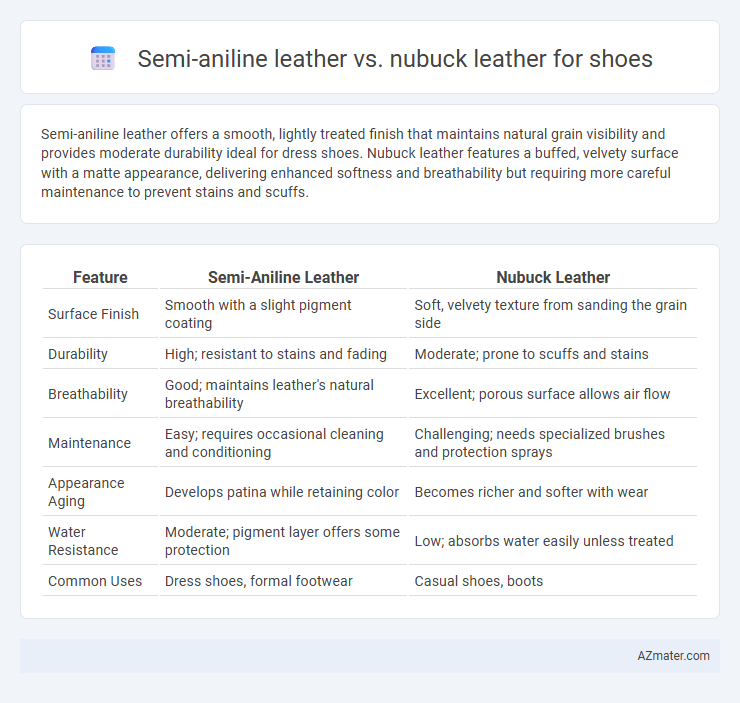Semi-aniline leather offers a smooth, lightly treated finish that maintains natural grain visibility and provides moderate durability ideal for dress shoes. Nubuck leather features a buffed, velvety surface with a matte appearance, delivering enhanced softness and breathability but requiring more careful maintenance to prevent stains and scuffs.
Table of Comparison
| Feature | Semi-Aniline Leather | Nubuck Leather |
|---|---|---|
| Surface Finish | Smooth with a slight pigment coating | Soft, velvety texture from sanding the grain side |
| Durability | High; resistant to stains and fading | Moderate; prone to scuffs and stains |
| Breathability | Good; maintains leather's natural breathability | Excellent; porous surface allows air flow |
| Maintenance | Easy; requires occasional cleaning and conditioning | Challenging; needs specialized brushes and protection sprays |
| Appearance Aging | Develops patina while retaining color | Becomes richer and softer with wear |
| Water Resistance | Moderate; pigment layer offers some protection | Low; absorbs water easily unless treated |
| Common Uses | Dress shoes, formal footwear | Casual shoes, boots |
Introduction to Semi-Aniline and Nubuck Leather
Semi-aniline leather is made from high-quality cowhide treated with a light transparent dye, preserving the natural grain and softness while offering moderate protection against stains. Nubuck leather originates from the outer layer of the hide and undergoes sanding or buffing to create a velvety, matte finish characterized by its durability and slightly rough texture. Both leathers provide unique aesthetic and tactile experiences, with semi-aniline focusing on natural appearance and nubuck emphasizing a soft, suede-like feel ideal for premium shoe craftsmanship.
Key Characteristics of Semi-Aniline Leather
Semi-aniline leather features a thin, transparent dye layer that preserves the natural grain and texture, offering a soft and natural feel with moderate protection against stains and fading. This type of leather retains visible pores and slight imperfections, adding to its unique character while maintaining breathability ideal for comfortable shoes. Compared to nubuck, which is sanded to create a velvety surface, semi-aniline leather provides a smoother finish with enhanced durability and easier maintenance, making it suitable for premium footwear.
Defining Features of Nubuck Leather
Nubuck leather is characterized by its soft, velvety surface created through sanding or buffing the outer grain, offering a fine texture and matte finish that resists wear and provides excellent breathability. Unlike semi-aniline leather, which maintains a smooth and glossy surface with light pigmentation for natural appearance and slight protection, nubuck's open pores make it more prone to stains but easier to maintain with proper care and conditioning. This durable yet delicate leather type is commonly used in high-quality footwear for its luxurious feel and distinctive aged patina.
Durability Comparison: Semi-Aniline vs Nubuck
Semi-aniline leather offers superior durability compared to Nubuck leather due to its protective topcoat that resists stains and scratches while maintaining a natural look. Nubuck leather, made from buffed grain, has a softer texture but is more susceptible to scuffs, water damage, and requires diligent maintenance to preserve its appearance. For long-lasting shoes, semi-aniline leather provides better resistance to wear and environmental exposure, making it the preferred choice for durability-focused footwear.
Comfort and Feel: Which Leather is Softer?
Semi-aniline leather offers a smooth, supple texture with a natural grain that retains some protection and softness, providing comfortable wear for extended periods. Nubuck leather features a velvety, suede-like finish achieved by sanding the outer surface, resulting in an exceptionally soft and plush feel that molds comfortably to the foot. For maximum softness and luxurious tactile comfort in shoes, nubuck leather typically surpasses semi-aniline leather due to its unique napped surface.
Appearance and Aesthetic Differences
Semi-aniline leather offers a smooth, slightly glossy finish that maintains some natural grain visibility while providing moderate protection, resulting in a refined and elegant shoe aesthetic. Nubuck leather features a soft, velvety texture created by sanding the outer surface, giving shoes a matte, plush appearance that emphasizes a casual yet sophisticated look. The choice between the two depends on desired durability and style, with semi-aniline promoting a polished look and nubuck showcasing a more relaxed, tactile quality.
Maintenance and Care Requirements
Semi-aniline leather requires regular cleaning with a damp cloth and occasional conditioning to maintain its natural appearance and prevent drying, as it has a thin protective coating that offers some resistance to stains and fading. Nubuck leather demands more intensive care, including the use of specialized brushes and cleaners to remove dirt without damaging its soft, velvety surface, alongside waterproofing treatments to protect against water and stains. Both types benefit from avoiding excessive moisture and direct sunlight, but Nubuck's open-pore texture makes it more susceptible to dirt and requires more frequent maintenance than semi-aniline leather.
Water and Stain Resistance
Semi-aniline leather offers moderate water and stain resistance due to its protective finish that preserves natural grain while repelling moisture and dirt. Nubuck leather, with its buffed surface, is more porous and prone to absorbing water and stains, requiring regular treatment with waterproofing sprays for enhanced protection. Choosing semi-aniline leather shoes ensures better durability against elements without compromising the leather's natural texture.
Price and Value Considerations
Semi-aniline leather offers a more affordable price point than Nubuck leather while maintaining a premium look and soft texture, making it a cost-effective choice for shoes. Nubuck leather, known for its velvety finish and durability, tends to be pricier but provides greater resistance to wear and an upscale aesthetic. Selecting between semi-aniline and Nubuck leather depends on balancing budget constraints with desired longevity and luxury in footwear.
Which Leather is Best for Shoes?
Semi-aniline leather offers a smooth surface with a protective topcoat, making it more resistant to stains and easier to maintain, ideal for everyday shoe wear. Nubuck leather features a soft, velvety texture from buffing the outer grain, providing a luxurious appearance but requiring more care to prevent water and stain damage. For durable, practical shoes, semi-aniline leather is best, while nubuck suits stylish, occasional-use footwear that benefits from its unique look.

Infographic: Semi-aniline leather vs Nubuck leather for Shoe
 azmater.com
azmater.com